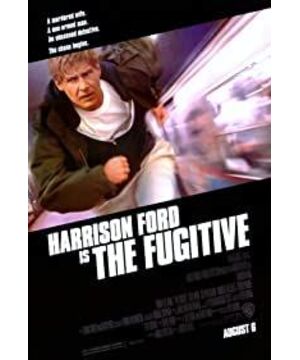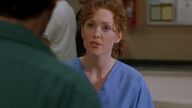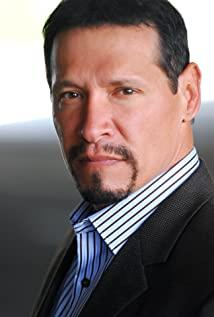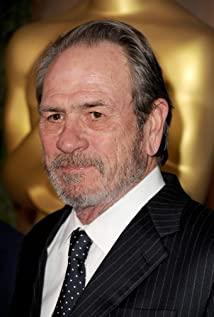The doctor named Richard Kimble played by Harrison Ford, whose eyes almost always hides extreme nervousness, is far more real than the comprehensive and perfect president of Air Force One. He was forced to always keep his head down, watching and walking around. He is no longer the enviable doctor at the dinner, but a fugitive. He got into the sewer, crossed the cold winter river with his wounds, and ran through the dead trees by the river on the night of a helicopter hovering, and was torn off his fake ID by a brave young female nurse. He did survive in the cracks like the protagonist of all commercial films, but he is not cool. Even in the scene where he ended up with the real murderer, there was no shot of him sweeping the enemy. There was no affair on the way to escape. There is only endless avoidance and pursuit and struggle in the quagmire to demand the truth. This image is moving. Through him, the characteristics of the film are revealed: it does not have an artistic film that will dig deep into the obscure brushstrokes under everyone's appearance, nor does it want to rely on the sensational and pretentious atmosphere created by a little deep commercial film. , And there is no mechanical insertion of conceptual symbols like the simplest commercial movies.
Such a measure is precious. There are no more than three lyrical parts in the film that everyone can be aware of, and the pause in each place does not exceed ten seconds. The lyrical content involves kindness, friendship and liberation.
At the county hospital, although the doctor pretended to be a handyman, he could not help changing the medical certificate of a black child. In the elevator, he quickly changed his diagnosis while talking to him. He frowned and wrote quickly, but the conversation with the child was full of kindness. The child answered him, and he said more without thinking. Then he sent him to the operating room. He turned and walked away, before just looking at the child, a tired smile appeared on his runaway face.
When explaining the scene, the director said that it was for his father. His father is a doctor and has been practicing medicine for many years. I like the director's explanation very much. This emotion did not make him exaggerate Kimble's image at the moment. The music did sound at the moment Kimble changed his diagnosis, but it was soft and slight, and it stopped after the child was picked up by another doctor. Kimble's close-up took only three seconds. Everything is full of real life beauty. In the history of film and literature, such details should be countless. But as long as it is still sincere, it will still look good.
The film will not explore what kind of psychology Kimble has towards life and society during his escape. Its purpose is to tell a story. These plots are short and few, which makes people feel that this is not the arrangement of the screenwriter and director, but the life itself. It is cold and objective-no one will be full of emotion when chasing and avoiding. However, the true warmth will always be revealed when we ourselves are not paying attention—the same, short, weak, and instantaneous. As in real life, the plot continues without stopping. The simplicity of such commercial films at this time is unparalleled. It does not pursue coldness or warmth, it just walks forward like a man — or, like a man.
In this film, the role of women is very low. All the doctors and nurses' assistants appeared, and they all passed by in a flash. But it does not affect the charm of the characters in the film. The characteristics of this film also come from this. It downplays lyricism on the plot, and downplays the feelings on the characters. Except for conspiracy and the relationship between objective characters, there are very few emotional relationships in the film. The only and most touching set of relationships is the friendship between Kimble and the law enforcement officer. They have only seen three sides in the whole film-although they have been at opposite ends from the beginning. The first time was in the sewer, Kimble held up his gun and shouted angrily to the marshal: "I did not kill my wife." A wonderful game of cat and mouse; finally, the marshal was in the car and opened his handcuffs. Kimble said, "Didn't you say you don't care?" The marshal smiled and said, "Yes. It doesn't matter." He knocked on the glass window and the car drove out of the flashing crowd.
The actual contact between them was just a few times. But for the Marshal, Kimble haunted him all the time. To solve the problem of Kimble's whereabouts, he must rearrange his past. He is still desperately hunting him down. However, the doubts in my heart are getting bigger and bigger. The film did not explain his sense of guilt, nor did it show any warmth beyond his position. He is serious, but can still tell jokes. He understands the loopholes in their work, but he is still calm. He has only one purpose, and that is to investigate. His distress is only related to this matter. The Marshal is a very attractive figure.
His wisdom, intuition, sense of humor, and iron-fisted personality are as likable as the clothes designer loves to add a red tone to his work clothes. He happened to form a wonderful scene that was both repulsive and common to Dr. Kimble, who was silent and inferior but beaten with astonishing courage every time. This is the reason why its structure is not good as mentioned before: because it carries the characters too rigidly, the best structure is worn out.
The film uses lens to narrate. Compared with the live stage, its advantage is the dazzling interspersed presentation. Therefore, perhaps just like the drama must go deep into the excavation of the scene, the film can only use this kind of lens narrative method to the extreme in the colorful storyline. The film is meticulously doing cat and mouse scenes. This is also the sincere devotion of the producer. Give full play to your imagination to carefully set up the wits and courage in the hunting scene. The plot is common and easy to understand, but it doesn't fall into the cliche. One of the most wonderful scenes is the chance encounter between Kimble and the marshal at the police station. The director said that this is a coincidence, but there may be such a coincidence. This coincidence is very good. It did not advance the plot-the marshal failed to catch Kimble in the end, so it was not made out of laziness. This may be due to the writer's own love for wisdom: the Marshal is on one side of the stairs, and Kimble is on the other side of the stairs. Neither of them knew that the other was here. They swayed a short distance away on a certain floor. The marshal turned abruptly, ran to the stairs where Kimble was and looked down. I saw a figure running. He yelled "Richard!" Kimble instinctively raised his head. The look of the two at that moment is unforgettable. That is a confrontation between two elites.
A subtle intuition, an action full of psychological mystery. But it's so natural again! It does not show off psychology and sixth sense. Still, without too much pause, the pursuers and fugitives began to run again. After a series of extremely dramatic plots, Kimble mixed into the joyous parade. The marshal finally missed.
These plots do not appear fancy. It is interesting, not because of accident, but because of the ever-changing energy that people burst out in crisis or emergency. It shows the extreme of physical and psychological interaction. Of course, we will be moved by the sad father’s psychology in "Son’s Room", even though he seems powerless; but Dr. Kimble, who lost his wife, did his best to deal with the danger and the future on the way. It can also move us. That is another kind of reality. In life, undercurrents are real, and appearances may not be real. It has a cold life texture, but it is also precious. It was like the last smile of the law enforcement officer to him, short-lived, sincere, and vague in meaning. Like an opponent, like a brother, like a friend, like a marshal to a good doctor, like a man to another man.
View more about The Fugitive reviews











